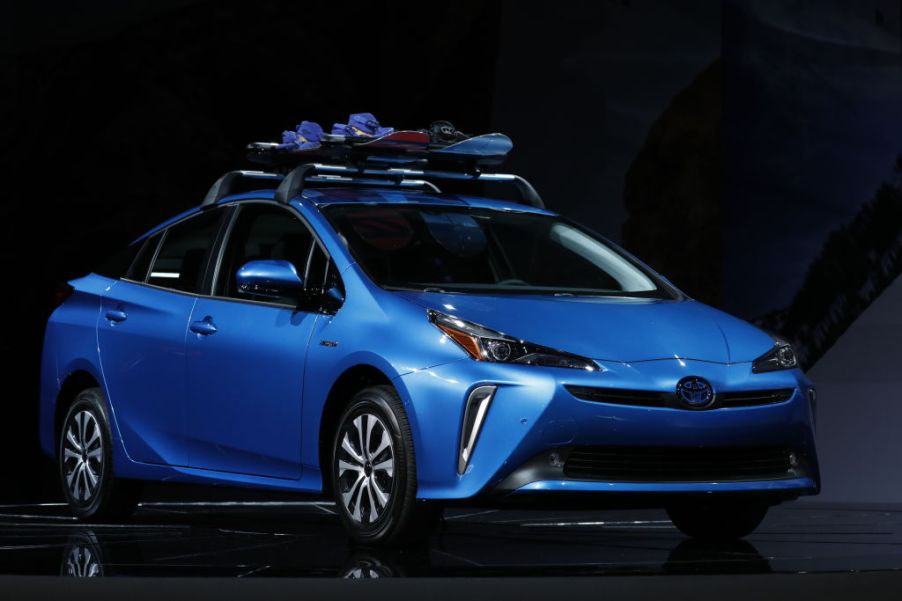
Is the Toyota Prius AWD-e the Ultimate Rideshare Car?
Toyota’s tag line “Let’s Go Places,” mainly correlates their entire lineup being reliable and fuel-efficient enough to go just about anywhere. But one thing that jumps out to us when reading those words is ridesharing, like taking an Uber or Lyft.
In case you haven’t noticed, many ride-share drivers drive Toyota Prii (plural for Prius) obviously due to their stellar fuel economy, but what about the drivers in snow states? Could the Toyota Prius AWD-e be the answer that rideshare drivers everywhere have been looking for?
Same, same but a little different
The Toyota Prius AWD-e came out for the 2019 model year. It sits on the same Prius platform that has existed since 2016, but with a couple of updates for more of a refreshed look. The head and tail lights are sleeker, thanks to Toyota shaving off a portion of them, otherwise, the car looks mostly the same.
The main difference between the standard Prius and the AWD variant is the 0.2 inches of higher ground clearance. Whether you’re an eagle-eyed onlooker or a casual observer, you probably wouldn’t have noticed.

Powertrain
Under the hood is a 1.8-liter, four-cylinder engine that is paired with an electric motor for a combined output of 121 horsepower. The standard Prius uses a lithium-ion battery, which is typically used because they are lighter and more efficient, however, the Prius AWD-e uses a 6.5-amp nickel-metal hydride battery because it’s able to withstand cold weather better.
The main change to the powertrain, though, is an electric motor that powers the rear wheels. It produces 7 horsepower and 40 lb-ft of torque, which isn’t a lot, but that’s mainly because this car isn’t all-wheel drive all the time.
The Prius AWD-e is mainly a front-drive car, but when slippage is detected, then the rear wheels kick in for more traction. The rears wheels are programmed to always gain grip from 0 to 6 mph and then 6 to 43 mph when needed. This is an added plus for snowy-weather driving.

In-cabin
Powertrain aside, the Prius AWD-e has the same in-cabin technology and interior room as a standard Prius. There’s plenty of room in the first row and the backseat, and the cargo room at 24.6 cubic-ft of volume for storing large suitcases and bags.
Ride-share drivers would like that there are two USB input jacks in the rear for passengers and a wireless charger upfront.
The 6.1-inch screen upfront is adequate for viewing the infotainment features and other information, however, the bummer is that Apple Carplay and Android Auto are not available, nor is navigation or satellite radio.
If anything, ride-share passengers will have to revert to use the old-school AUX jack or connecting to Bluetooth to play their own tunes during the ride. Welcome back to 2012.

Fuel economy
For ride-sharing, fuel economy is of the utmost importance and luckily, the Prius AWD-e follows suit with its Prii brethren and achieves 52 mpg in the city and 48 mpg on the highway. For reference, the standard Prius gets 54 in the city and 50 on the highway, so the all-wheel drivetrain does hinder the numbers a little.
Cost is why it’s the ultimate
Opting for the all-wheel drivetrain in a Prius will get you a starting price of about $26,935, which is about $1,400 higher than the standard model. Keep in mind that this is much lower than other current hybrid AWD models on the market including the RAV4 Hybrid and the Ford Escape Hybrid.
For those not interested in an SUV platform, though, the Toyota Prius AWD-e is probably the most sensible, capable, affordable, and fuel-efficient all-wheel-drive hybrid car that you can currently buy.
Other than the antiquated infotainment system, if you drive for a rideshare service and just need an affordable car that gets you to most places that others cannot, then the Prius AWD could be the ultimate solution.



